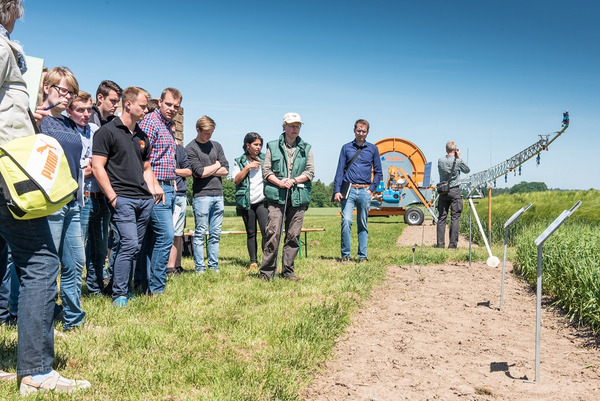The event was hosted by the Chamber of Agriculture of Lower Saxony (LWK; leader of the DiverIMPACTS case study "Crop diversification to improve water quality in catchment basin" and the field experiment 2), the State Office of Mining, Energy, and Geology (LBEG), and the Lower Saxony Water Management, Coastal Defence, and the Nature Conservation Agency (NLWKN).
“We want to introduce the importance of agriculture for groundwater protection, especially to young farmers – as they will need to collaborate actively to reach the goals of the European Water Framework Directive,” said Andrea Knigge-Sievers, an expert in water protection of the LWK and initiator of the event. Six stations were prepared in the fields to present and discuss recent results in Hamerstorf, especially undersown grasses in cereals for water protection crop rotations and how organic fertilizers should be used to guarantee high nitrogen-efficiency are tested. For example, perennial ryegrass was tested as an undersown grass to fix nutrients and to avoid leaching.
Along with several variants of crop rotation, ten different fertilization variants were introduced. With the help of suction probes, the experts of LBEG were able to determine nitrate concentrations directly from the water leakage. So the direct impact of nitrogen fertilization on groundwater was demonstrated.
The goal of the field work was the provision of data, which showed the success of reduced fertilization and the introduction of catch crops. In the ideal scenario, fertilizer savings – after fertilized catch crops, for example – is possible. From this, both the environment and farmers can benefit. The field trials in Hamerstorf were financed by the water treatment authority of Lower Saxony.
Initial results already exist. Experts from LWK and LBEG found that after potatoes, clearly more nitrogen leached out in the winter of 2014/2015 than after winter rye. This effect, amongst other things, could be attributed to the higher airflow in the soil during the potato harvest and following nitrogen mineralization. Whether the observed effects were only short-term or could be achieved long-term will be shown in the upcoming years.
Contact
Hauke Ahnemann, LWK, Germany

 Souhaitez-vous ajouter le site web à l'écran d'accueil ?
Souhaitez-vous ajouter le site web à l'écran d'accueil ?